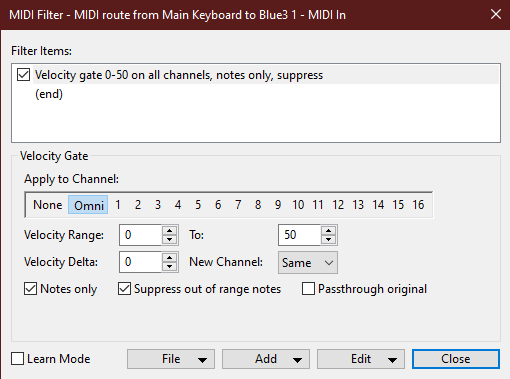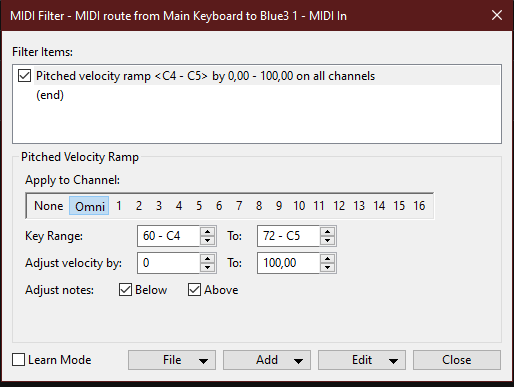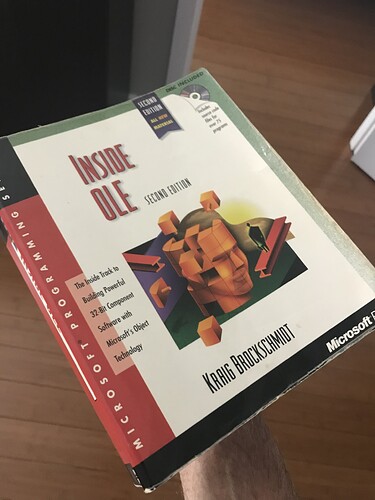I hope I’m doing it right here. I first wanted to continue my initial thread: So I have reached a tipping point with my Advance/VIP/laptop setup"… but then I realized that my first impressions with the Performer trial version would be quite long… so please bear with me here.
0.very first, probably biased and definitely incomplete, initial impressions to begin with:
- Object design and concepts are super clear - I love the vocabulary - Abstractions make sense to me and I definitely feel that a lot of things just “click together”
- Onscreen keyboard is best in class
- Graphical routing is good, but I quickly switched to plain old tabular version
- MediaPlayers… how could I live without this? I asked for a very basic version of this in VIP since day 1. I have to resort to create a patch in Omnisphere with a custom wave file and assign a routing to a pad on my keyboard for each sample I need to trigger. I don’t know how it could be more cumbersome.
- Touch mode and big enough buttons… not impressed at first, but of course, need to experiment a lot more, especially with the live mode.
- Community is awesome: thank you all for your insight
- I love the transparency on the product (trello!!) and you seem to even permit voting on features
- Licensing seems really sensible
- Initial impression on the Control Bar is somewhat disappointing - but again I need to explore more and formalize what I mean.
1. VST Scan
Initial VST scan did not complete (I stopped it after one 1 hour). It turned out to be stuck while scanning… VIP!
VIP was running in the background (in non exclusive windows audio mode), as I was reviewing set lists. So probably not an issue with Cantabile here if the two were not playing nicely. While stopping the scan, this completely stopped Cantabile which continue scanning VSTs upon restart, skipping VIP. Fair enough.
I was planning to rescan later and was eager to make a test Song with a simple Blue3 insert.
After toying a little bit with Blue3, I decided to rescan (quick) the VSTs and Cantabile crashed, reporting an issue with Blue3.
After restarting again, and shuting down VIP in background, I did scan again the VSTs from the “Insert Plugin” window this time (was glad to find it here too). This time the VST scan completed but cpu was heavily hammered compared to the first time. And Cantabile was constantly taking focus from other Windows (flickering on the lower right scanning icon).
And then VIP was available in the plugins! And it seems to work as expected from here (not had a long time to experiment with it)
All of this is not crucial as I don’t plan to initial setup/scan very often. Just wanted to share my initial feedback. And above all, this is the first impression you get from the product.
2. Splits
I heavily rely on splits, sometimes with 6 or 7 splits on my keyboard. This is probably a behavior coming from mixed reasons: an historical behavior from previous hardware synth, the need to be very agile setup wise, the need to be very visbile with only one stage keyboard (yes, some keyboardists are showmen!), my minimalist vision… and maybe, just maybe, this was a way to be very fast in VIP… no need to wait for song switching when you all keep it into one song.
By the way, I can foresee I will use states a lot, which are not available in VIP (but I had a very quick, already wired for me, way to overcome this: one button press and the pads are giant mutes buttons for the different layers).
Anyway, back to splits: I see how to manage them in Cantabile at first glance, which is nice, but I believe they can be improved a lot:
-
While rehearsing/programming, I need to be VERY fast when creating/updating splits. For example assigning range should be as easy as holding a big “lower key” button on the GUI while pressing the corresponding key on the main or onscreen keyboard. Even better, a no brainer shortcut like holding F1 for lower key (F2 for higher key) while pressing a key on the synth keyboard (like C4) should assign this parameter without any fuss (maybe just a quick toast notification would be nice)
-
What I need ultimately, and so far, only Omnisphere has it, is a a way to control velocity ranges of the splits. They have screenshots here: https://support.spectrasonics.net/manual/Omnisphere/stack_mode/index.html
VIP does not offer this neither. This would save me for some bloops in gigs. This would, above all, allow me to be quicker and more creative: for the moment, I can only do this in Omnisphere, but this means creating multis inside multi (so strange) and I would like to do it cross plugins of course.
I’m probably a lone boy on this one, but that would be a killer feature for me.
3. Things I need to explore:
3.1. I would like to be able to press a dedicated button on my controller and enter “Mixing mode”. In this mode, main potentiometers (1-8) would control volumes and main pads would control mute on/off for plugins 1-8. And then pressing another dedicated button on my controller would go to the “Back to usual” mode, where all other buttons go to whatever is assigned
If I’m correct, I need to try programming this on the “Background rack” to have this as a global behavior. I have no clue for the moment if this is doable and would love some insight on this.
3.2. Tap tempo. I need to try tap tempo on my controller and do a midi clock synchronization. I have good hopes on this but lacked time to test.
A drummer I play with also has a connected metronome watch on a master midi clock, if I recall correctly. I would definitely have a new best friend if we could synchronize click together this way.
3.3. VIP does not have the “Note” feature. I resort to… brace yourself… use Powerpoint here. Powerpoint is super fast, super stable, low footprint (you read that right) and of course super customizable. So alt tab and powerpoint in full screen is the only thing I have to do (remember that in VIP with the Advance, I don’t need to ever look at VIP itself while playing as I have all the information I need on the Advance’s screen itself). I was even ready to quickly hack a trigger a powerpoint in
=> So… here is probably the stupidiest request for @brad ever: do you believe I could embed powerpoint slides in the Note section? like old fashion OLE binding? please feel free to freak out.
3.4. I really need to explore states. It seems to be what I really missed.
4. Conclusion (for now)
Well done @brad and community, I’m hooked. I still need to prove some key points in my setup and play style. The same way I did with VIP a few years back. Without going too much deeper into details, you can imagine I resorted to a lot of customization in my current worfklow (did I mention I use Midi-OX for my routing to bypass VIP’s limitations?)
I definitely need more than a month to port my workflow and I will have to keep an open mind and do things differently sometimes. Biggest challenge is I have to convince myself about the hard work to come and find the time for that.
For the fast browsing/layering of plugins with simple drag and drops, well, that will probably not happen in Cantabile anytime soon but I cannot go back from that. The feel of a “few” thousands sounds at my fingertip is incomparable. Let’s still have it by embedding VIP for now.
I hope, in the future, I can make suggestions to have “quick wins” on this aspect… like a faster GUI for cataloguing and inserting Plugins/Favorite presets (yes, I see where Cantabile is at the moment with the Insert Object > Insert Plugin > Presets user flow, but I strongly believe it can offer a lot more in terms of UX here)… I still keep the dream that if Cantabile offers a preset browser one day, I will be able to write a setting migration program between both worlds.
Again thanks to all @here!
Seing people reading and reacting to my elucubrations… well, this is a feeling I did not have since a long time.





